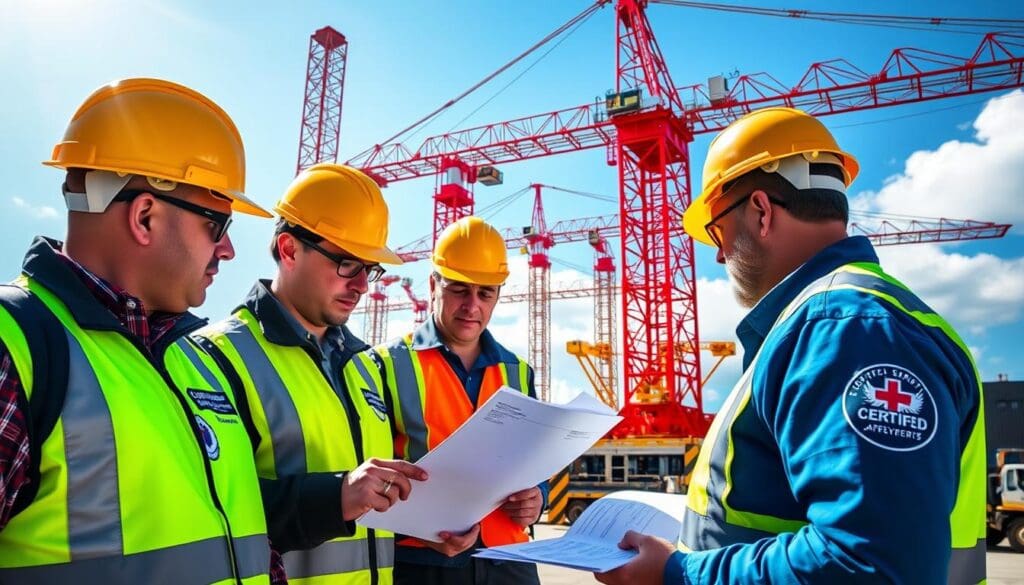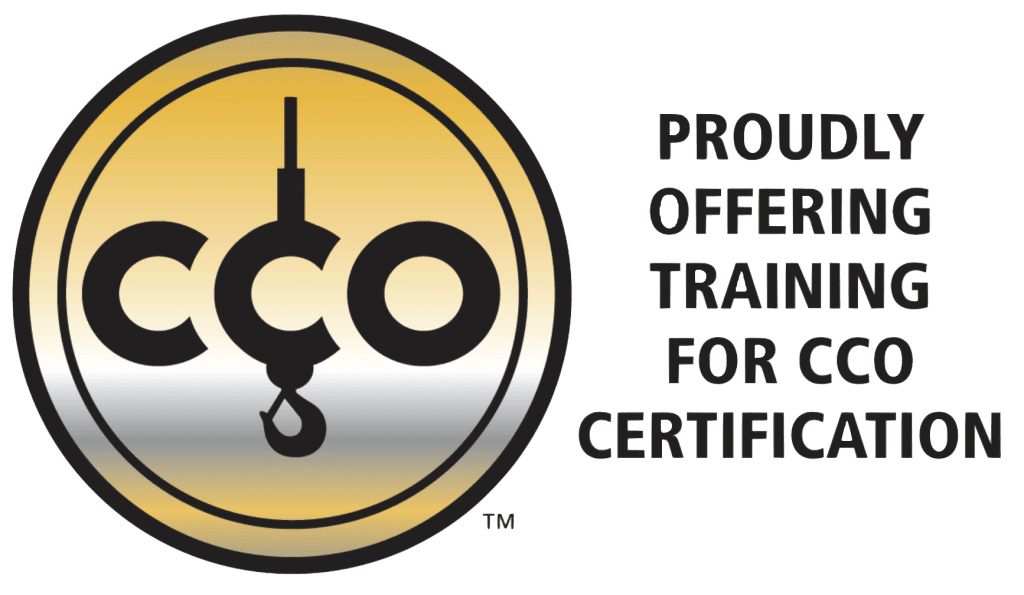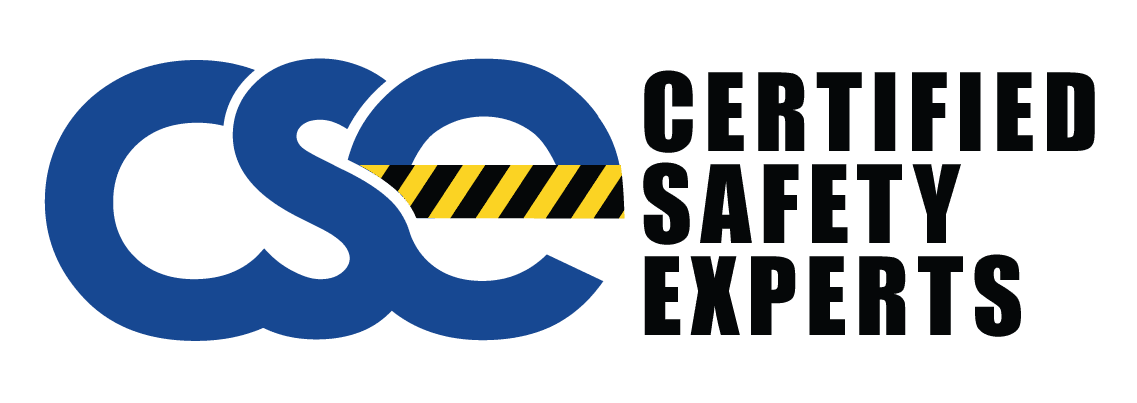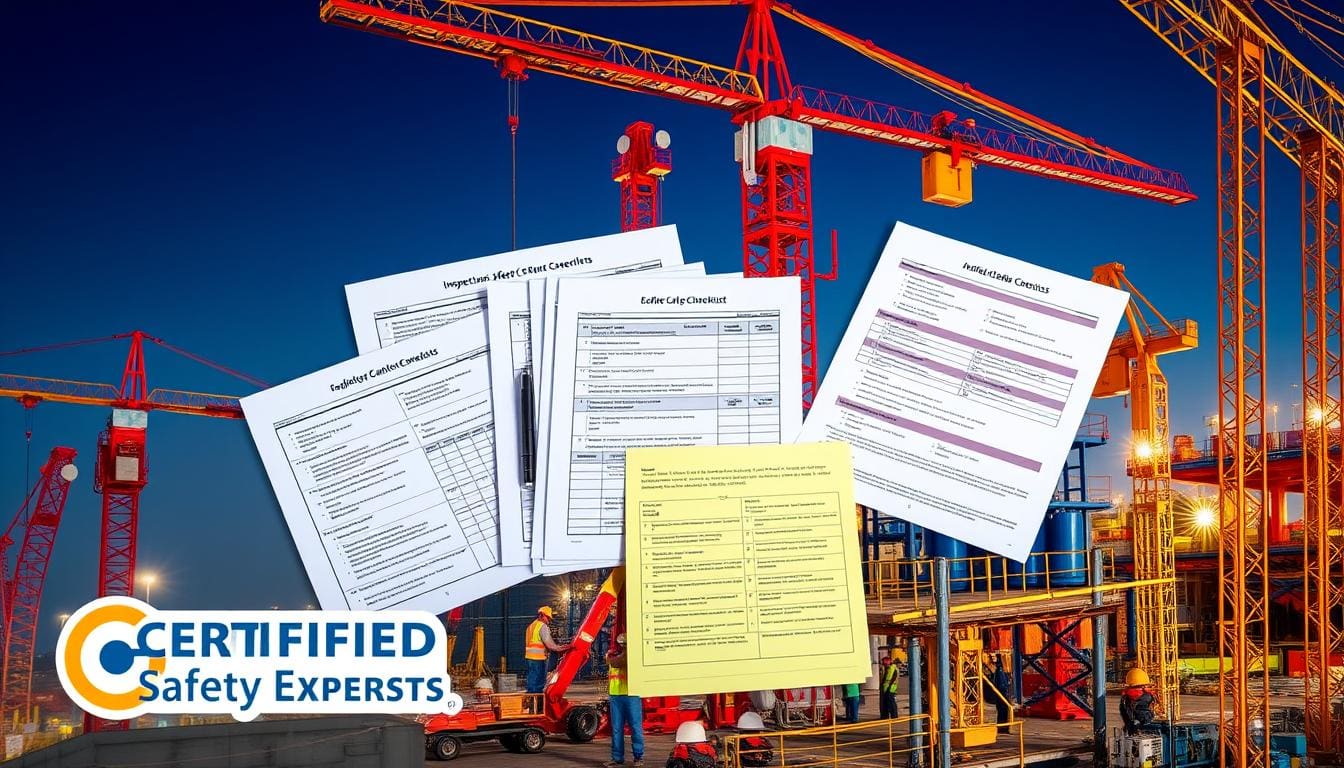Why do construction and manufacturing accidents happen even with strict safety rules? The key often lies in the details of crane inspection reports. These reports are more than just paperwork. They are crucial for making sure safety compliance and following strict OSHA regulations. They check the condition and safety of crane equipment.
These reports are key for spotting dangers before they turn into big problems. This helps protect lives and promotes a safe work culture in the industry.
Key Takeaways
- Crane inspection reports are key for safety and following OSHA rules.
- Regular checks spot dangers and stop accidents.
- Good inspection reports help build a safety culture in construction and manufacturing.
- Certified experts should do these checks for accuracy and trustworthiness.
- Crane inspection reports show a company’s effort to keep equipment safe.
Importance of Crane Inspection Reports
Crane inspection reports are key to keeping things running smoothly and keeping people safe at work. They help spot problems early, avoiding big delays and making sure everyone stays safe.
Why Crane Inspections Are Crucial
The crane inspection importance is huge. These checks make sure the crane’s parts work right. This stops sudden breakdowns and keeps the crane running well. Plus, having certified crane inspectors do the job means we follow all safety rules.
Impact on Workplace Safety
Regular crane checks make the workplace much safer. They find and fix problems before they cause accidents. This keeps workers safe and helps everyone work better.
Role of Certified Crane Inspectors
Certified crane inspectors are key to keeping cranes safe and efficient. They make sure cranes follow all safety rules and standards. Their work is vital for preventing accidents and keeping the workplace safe.
Qualifications of a Certified Crane Inspector
To be a certified crane inspector, one needs special training and certifications. These prove they know a lot about crane mechanics, safety, and how to inspect them. They complete tough programs to get certified from trusted organizations. This makes sure they can check cranes properly.
Responsibilities During an Inspection
Certified crane inspectors have many tasks during an inspection. They check crane parts for any wear or damage. They make sure cranes work right and follow safety rules. Their detailed checks help make sure cranes are safe and reliable.

Key Elements of a Crane Inspection Checklist
A detailed crane inspection checklist helps inspectors during evaluations. It’s a key tool that makes sure every part of the crane is checked and kept in good shape. By using a daily inspection protocol and a thorough annual crane review, safety and compliance can be kept up.
Daily and Monthly Checklist Items
Daily and monthly checks look for visible damage, control systems, and routine issues. A strict daily inspection protocol helps spot problems early. This keeps the crane safe and running well for longer.
- Check for visible damages or deformities
- Inspect control mechanisms for proper functionality
- Examine wire ropes and pulleys for wear and tear
- Test limit switches and safety devices
- Ensure all warning labels and signage are intact and legible
Annual Inspection Requirements
The annual crane review looks deeper into the crane’s structure and how it works. These detailed checks find issues that aren’t seen in daily or monthly checks.
- Thorough inspection of all structural components for stress or fractures
- Comprehensive evaluation of electrical systems
- Detailed examination of load-carrying parts and mechanisms
- Verification of hydraulic systems and components
- Review of maintenance records to ensure compliance with inspection protocols
Crane inspection checklists are crucial for keeping cranes safe and efficient. Following these checklists closely can greatly lower accident risks and make the equipment last longer.
Understanding OSHA Standards for Crane Inspections
Knowing OSHA standards is key for doing crane inspections right and writing detailed reports. These standards give clear rules for how and when to inspect cranes. They help make sure the job site is safe and reduce injury risks. Inspectors need to know these standards well to make sure cranes are safe.

- Crane inspection rules call for regular and routine checks.
- Following OSHA’s guidelines helps meet safety standards.
- It’s important for inspectors to keep up with OSHA standards through training and updates.
Sticking to crane inspection rules helps companies follow OSHA standards and create a safer work place. Using these standards correctly leads to better safety, lowers accident chances, and makes the workplace safer overall.
Maintaining Detailed Crane Maintenance Records
Keeping detailed crane maintenance records is key. It helps track repairs, inspections, and changes over time. This way, owners and operators can see the crane’s condition and plan for future needs. Good records are important for following rules, making warranty claims, and keeping things safe.
How to Document Maintenance Tasks
Documenting maintenance tasks is a detailed job. Start by noting the date and time of each task. Then, list the tasks done, parts replaced, and any problems found. Using digital tools can make this easier and keep records accurate and easy to find.
The Importance of Accurate Record-Keeping
Keeping accurate records is vital for safety and following the law. Wrong or missing records can cause big problems, like equipment failure or fines. Good records help with warranty claims, show maintenance is done, and keep safety high.
- Update records right after maintenance is done.
- Write detailed descriptions of each task for clarity.
- Use digital systems for better accuracy and easy access.
Inspection Documentation and Reporting
Keeping accurate records of crane inspections is key to a strong safety audit trail. These records prove compliance with safety rules during audits. They make sure everyone knows what’s going on and talk about safety issues quickly.
Inspection reports do more than just meet rules. They help keep operations safe by checking crane conditions and fixing problems early. This way, safety standards are met, and work runs smoothly.
A solid safety audit trail helps deal with safety issues fast and well. Companies that focus on detailed reports are ready for audits. They keep their workers safe and follow the rules. Good inspection records are essential for a safe and rule-following workplace.




